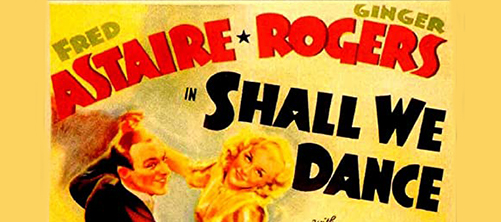Pas de biographie disponible.
Compositeur Musique additionelle Librettiste Parolier Metteur en scène Chorégraphe Producteur création Producteur version

Film
Musique: George Gershwin • Paroles: Ira Gershwin • Livret: Allan Scott • Ernest Pagano • Production originale: 1 version mentionnée
Dispo: Résumé Commentaire Génèse
Shall We Dance, released in 1937, is the seventh of the ten Astaire-Rogers musical comedy films. The idea for the film originated in the studio's desire to exploit the successful formula created by Richard Rodgers and Lorenz Hart with their 1936 Broadway hit On Your Toes. The musical featured an American dancer getting involved with a touring Russian ballet company. In a major coup for RKO, Pandro Berman managed to attract the Gershwins – George Gershwin who wrote the symphonic underscore and Ira Gershwin the lyrics – to score this, their second Hollywood musical after Delicious in 1931.
Genèse: Production While the film – the couple's most expensive to date – benefits from quality comedy specialists, opulent art direction by Carroll Clark under Van Nest Polglase's supervision, and a timeless score which introduces three classic Gershwin songs, the convoluted plot and the curious absence of a romantic partnered duet for Astaire and Rogers – a hallmark of their musicals since The Gay Divorcee (1934) – contributed to their least profitable picture to date. Astaire was no stranger to the Gershwins, having headlined, with his sister Adele, two Gershwin Broadway shows: Lady Be Good! in 1924 and Funny Face in 1927. George Gershwin also accompanied the pair on piano in a set of recordings in 1926. Rogers first came to Hollywood's attention when she appeared in the Gershwins' 1930 stage musical Girl Crazy. Shall We Dance was named at the suggestion of Vincente Minnelli, who was a friend of the Gershwins. Minnelli originally suggested "Shall We Dance?" with a question mark, which disappeared at some point. Reception Shall We Dance earned $1,275,000 in the US and Canada and $893,000 elsewhere, resulting in a profit of $413,000, less than half the previous Astaire-Rogers film. It was neither a box office nor a critical success, and was taken as an indication that the Astaire-Rogers pairing was slipping in its audience appeal.
Résumé: Peter P. Peters (Fred Astaire), an American ballet dancer billed as "Petrov", dances for a ballet company in Paris owned by the bumbling Jeffrey Baird (Edward Everett Horton). Peters secretly wants to blend classical ballet with modern jazz dancing, and when he sees a photo of famous tap dancer Linda Keene (Ginger Rogers), he falls in love with her. He contrives to meet her, but she is less than impressed. They meet again on an ocean liner traveling back to New York, and Linda warms to Petrov. Unknown to them, a plot is launched as a publicity stunt "proving" that they are actually married. Outraged, Linda becomes engaged to the bumbling Jim Montgomery (William Brisbane), much to the chagrin of both Peters and Arthur Miller (Jerome Cowan), her manager, who secretly launches more fake publicity. Peters and Keene, unable to squelch the rumor, decide to actually marry and then immediately get divorced. Linda begins to fall in love with her husband, but then discovers him with another woman, Lady Denise Tarrington (Ketti Gallian), and leaves before he can explain. Later, when she comes to his new show to personally serve him divorce papers, she sees him dancing with dozens of women, all wearing masks with her face on them: Peters has decided that if he cannot dance with Linda, he will dance with images of Linda. Seeing that he truly loves her, she happily joins him onstage.
Création: 7/5/1937 - *** Film (***) - représ.

Film
Musique: George Gershwin • Victor Baravalle • Paroles: Livret: Ernest Pagano • P.G. Wodehouse • PJ Wolfson • S.K. Lauren • Production originale: 1 version mentionnée
Dispo: Résumé Commentaire
A Damsel in Distress is a 1937 English-themed Hollywood musical comedy film starring Fred Astaire, Joan Fontaine, George Burns, and Gracie Allen. Loosely based upon the P.G. Wodehouse 1919 novel of the same name, and the 1928 stage play written by Wodehouse and Ian Hay, it has music and lyrics by George and Ira Gershwin, and was directed by George Stevens, the second (and last) Astaire musical directed by Stevens; the first was Swing Time.
Genèse:
Résumé: Everyone on staff at Tottney Castle knows that the lovely Lady Alyce Marshmorton (Joan Fontaine) must marry soon, so a wager is proposed as to the identity of the lucky man. With all the likely candidates already claimed, young footman Albert (Harry Watson) places a bet on a "Mr. X," someone totally out of the blue. Lady Alyce secretly has a romantic interest in an American no one from her family has yet met. She leaves the castle one day to venture into London, where by chance she encounters Jerry Halliday (Fred Astaire). He is an American entertainer, accompanied by press agent George (George Burns) and secretary Gracie (Gracie Allen), but he is not well enough known to be recognized by Lady Alyce. Jerry is incorrectly led to believe that he is the American that Lady Alyce is in love with. He goes to the castle, encouraged by Albert but discouraged by Keggs (Reginald Gardiner), a scheming butler whose money is on another beau. The closest Jerry can get to Lady Alyce is a castle tour, at least until Albert can sneak him upstairs. False impressions abound, as Jerry also fails to recognize Lady Alyce's father (Montagu Love), the lord of the manor. He is slapped in the face in a Tunnel of Love, misunderstanding the young lady's intentions entirely. In the end, however, he and Lady Alyce do find romance. The song "Things Are Looking Up" by George and Ira Gershwin appears in the film.
Création: 19/11/1937 - *** Film (***) - représ.